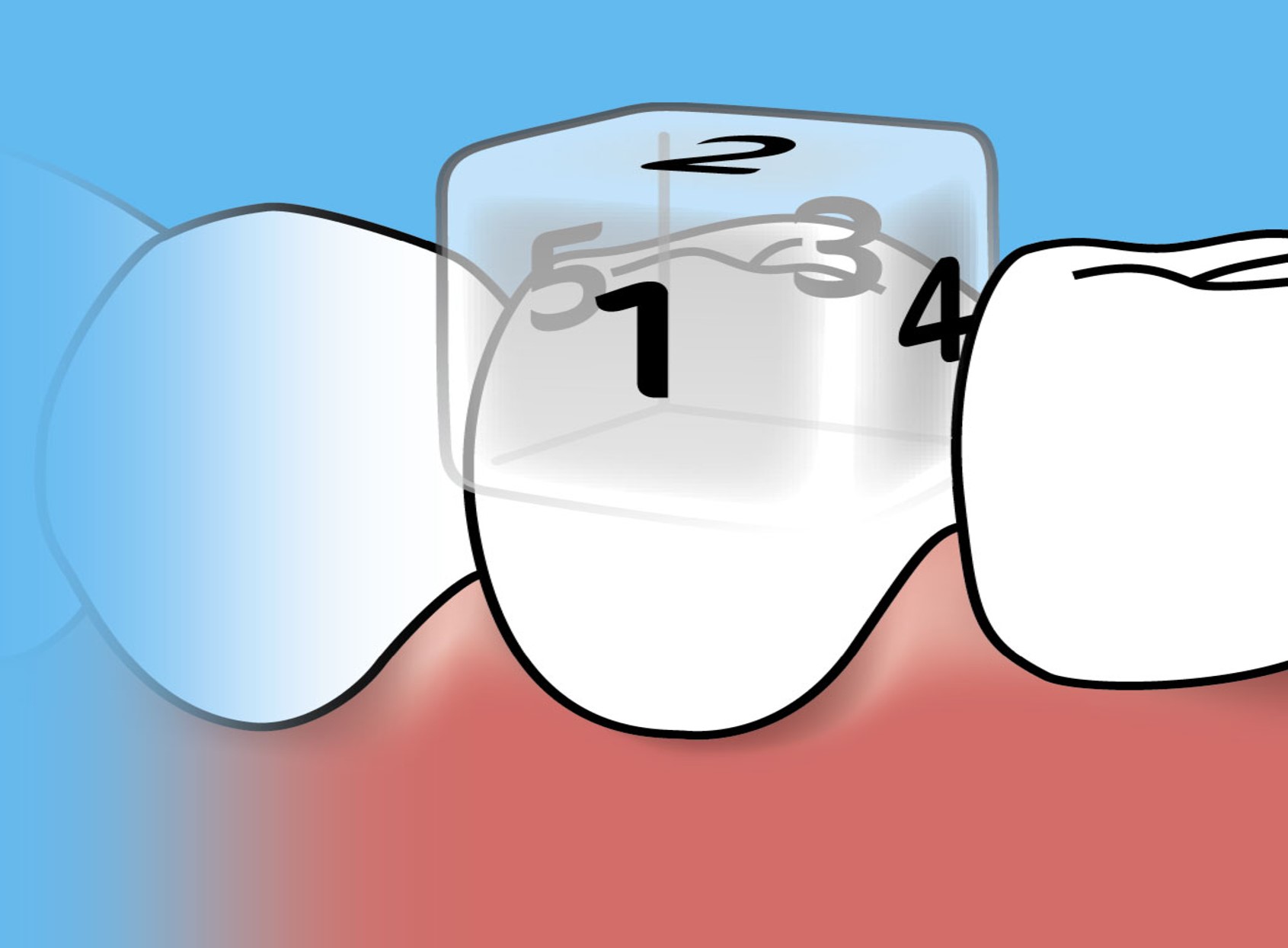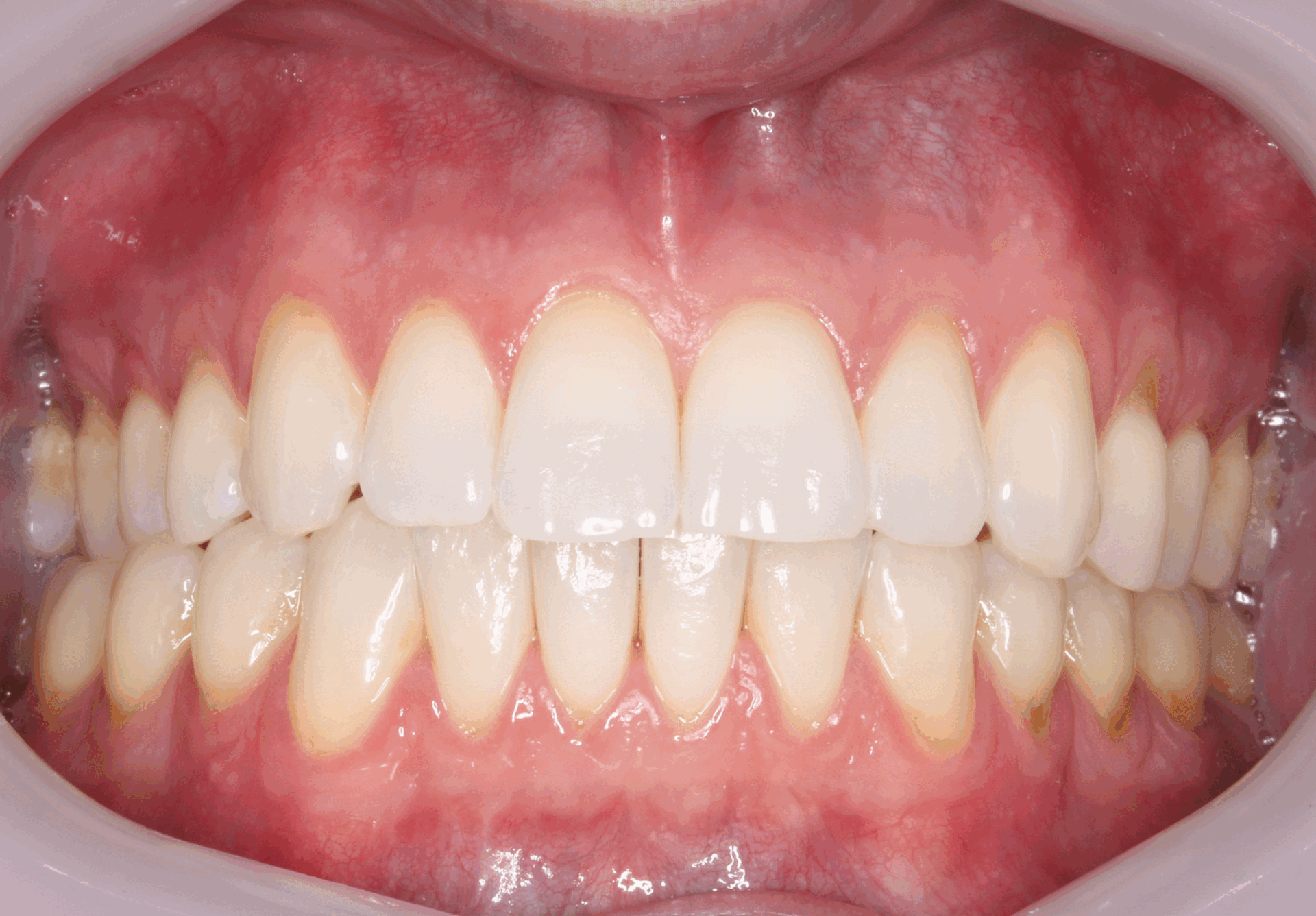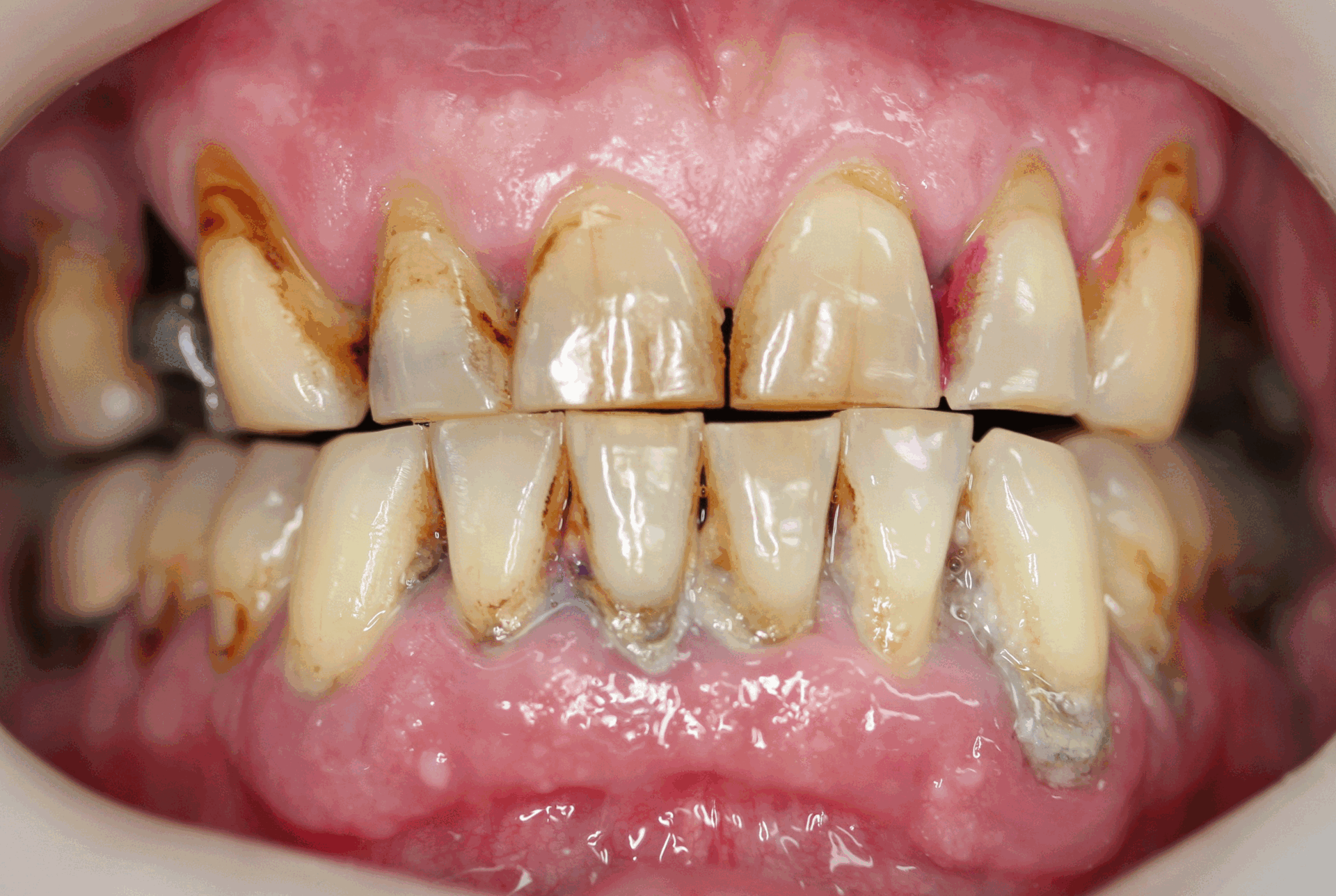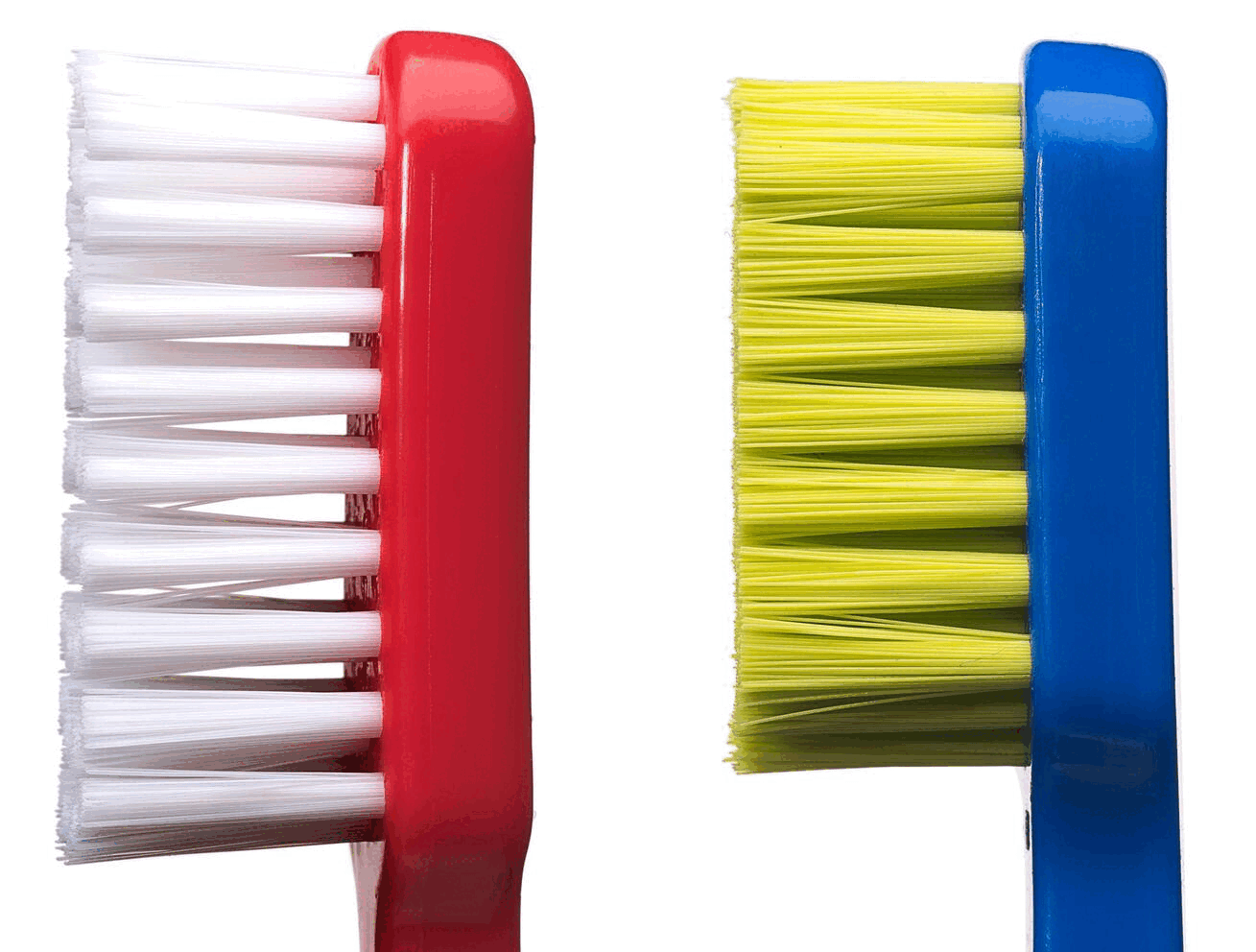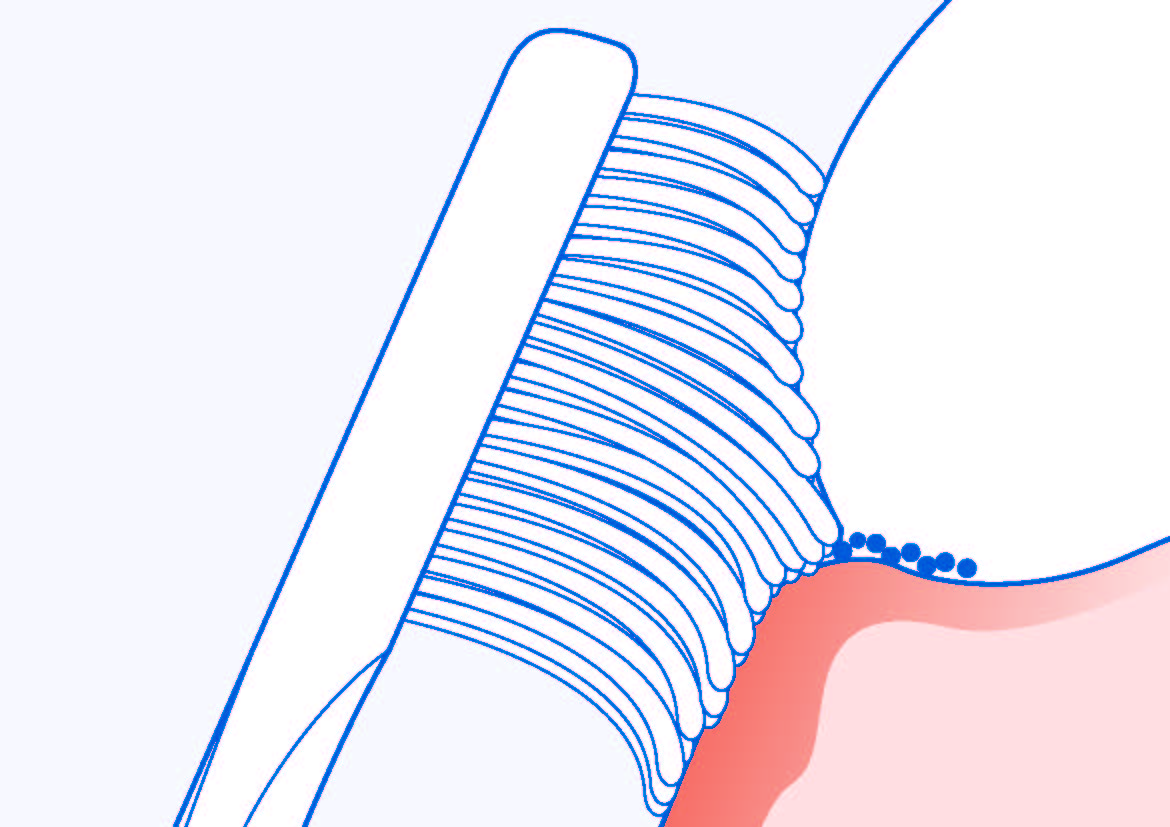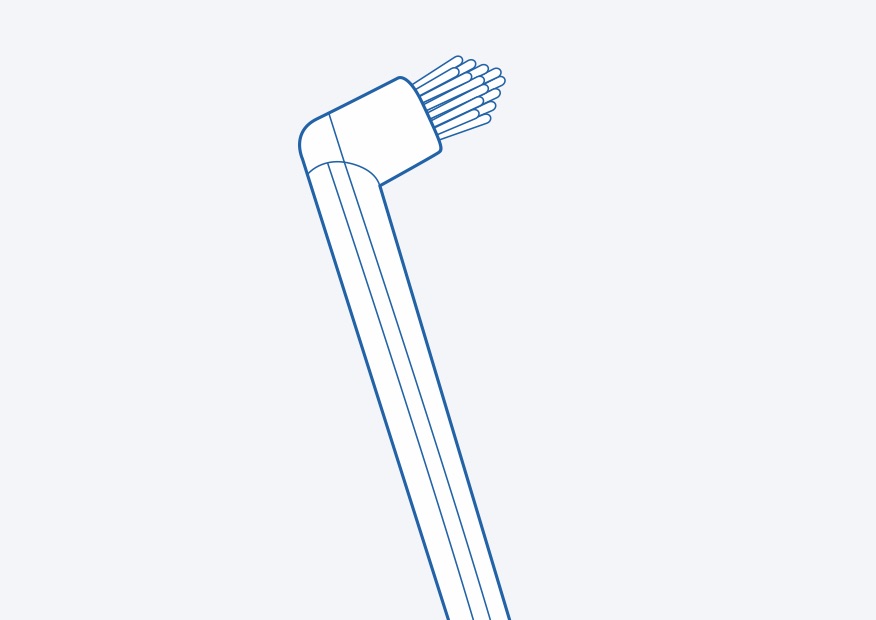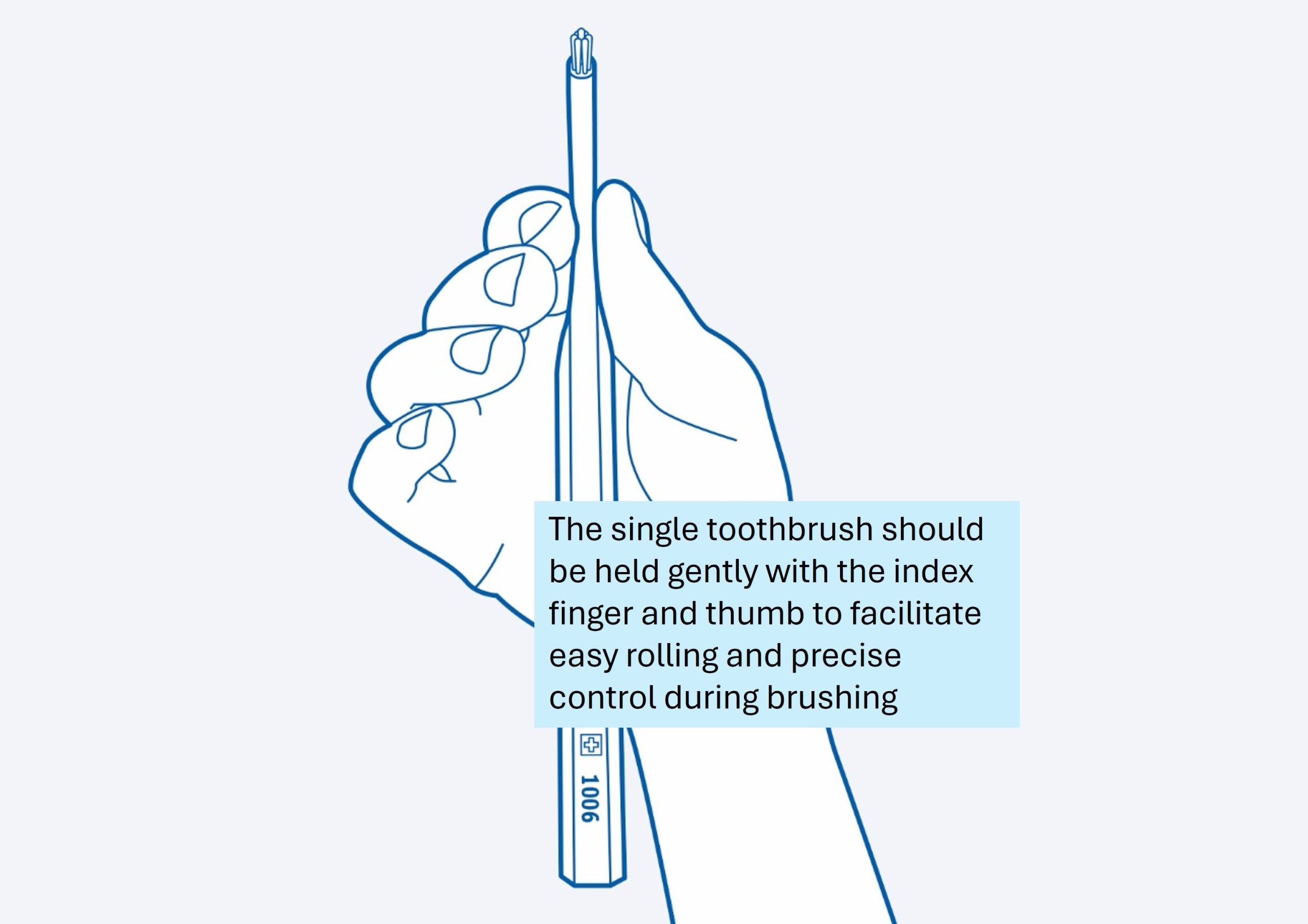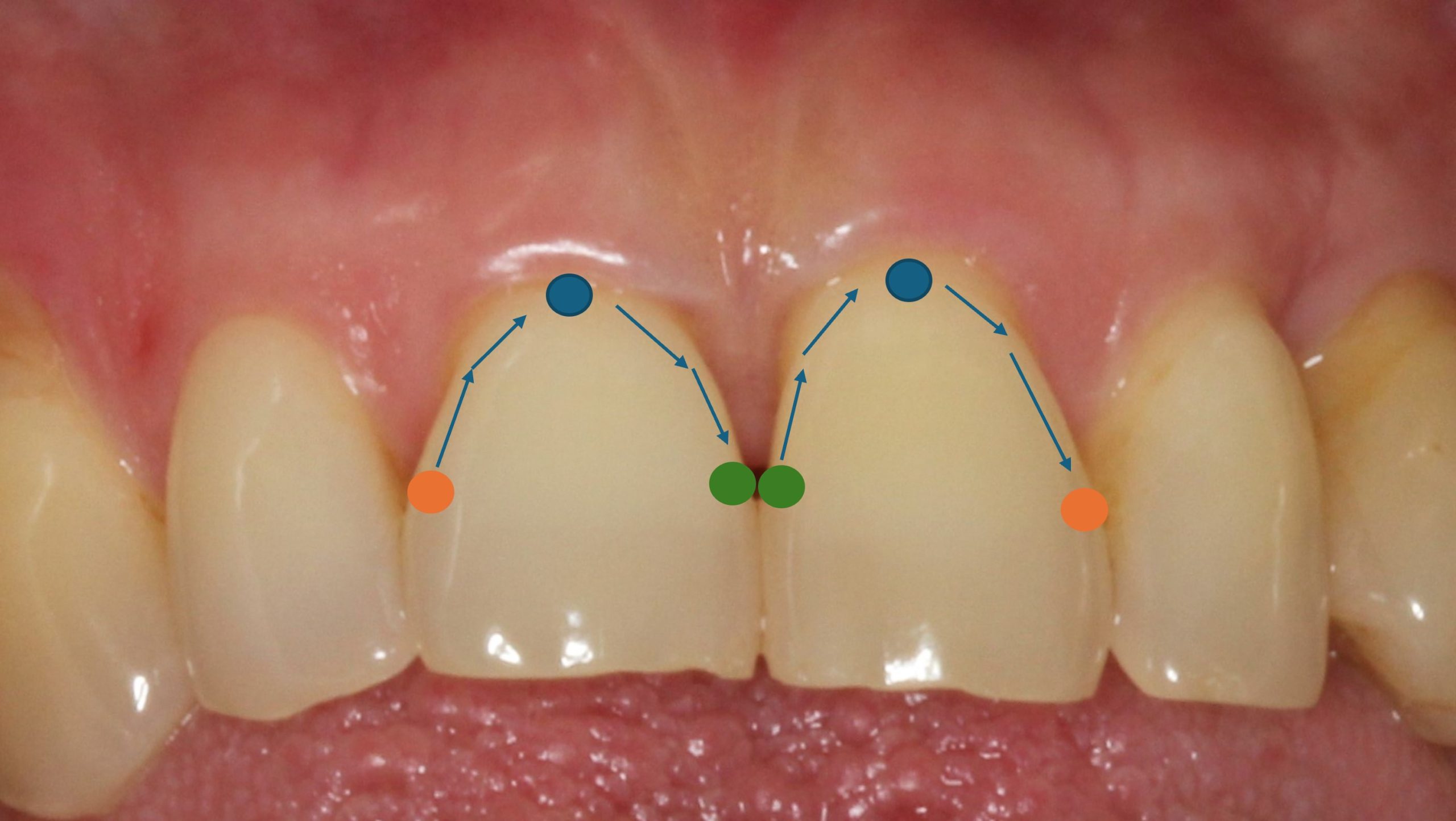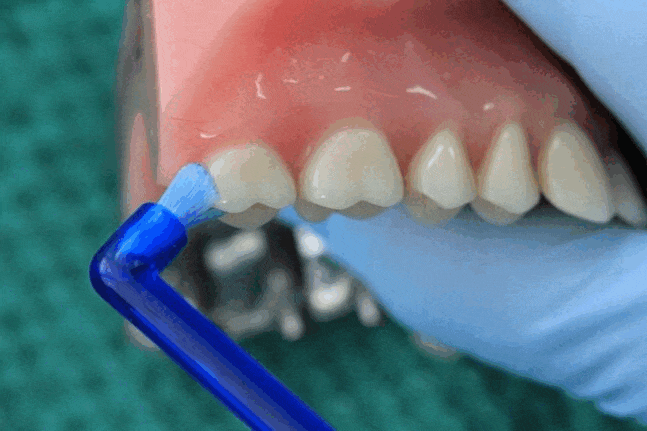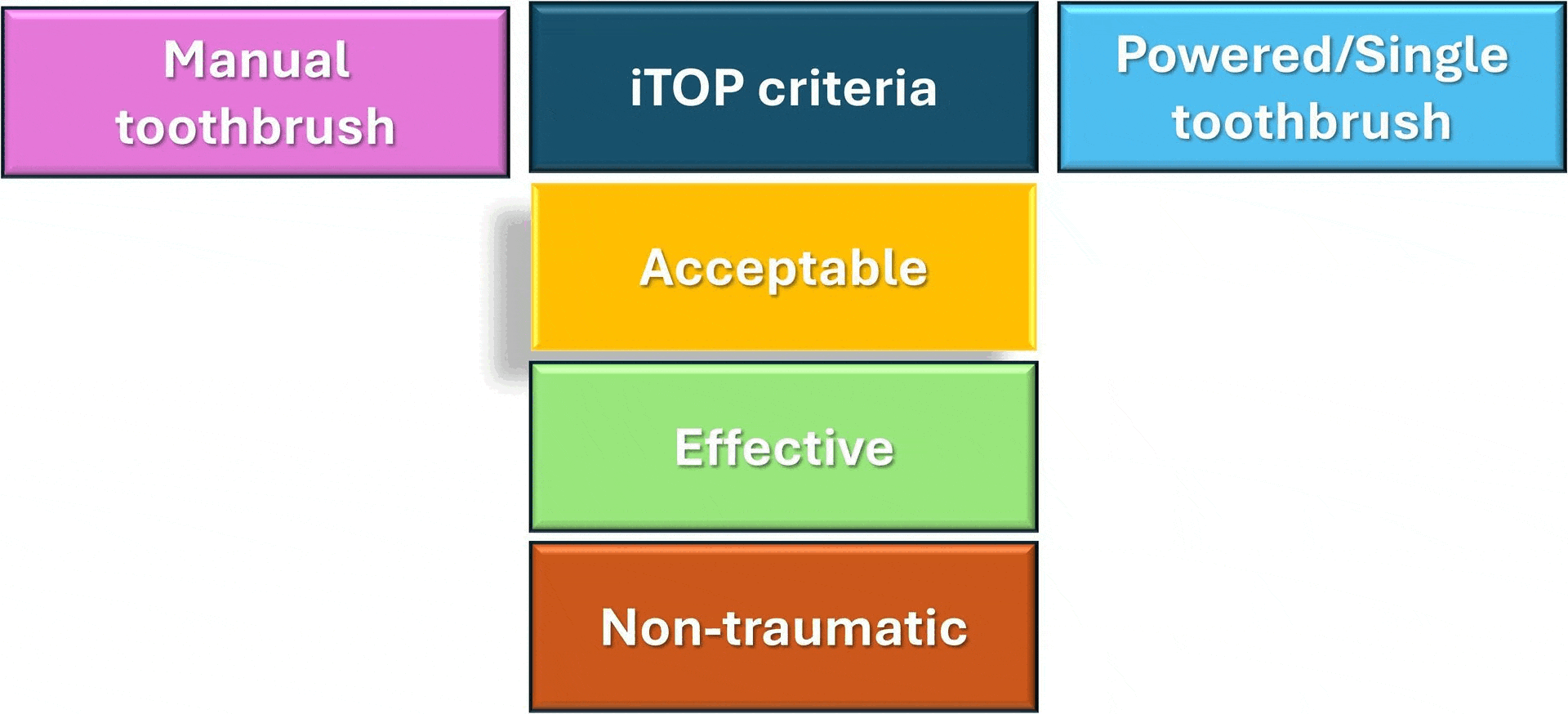iTOP
Mastering Mechanical Biofilm Control with Individually Trained Oral Prophylaxis (iTOP)
The Alpha and Omega of Lifelong Oral Health
In the oral cavity of an average person with 28 teeth (excluding wisdom teeth), 140 tooth surfaces need to be cleaned regularly to prevent the two most common oral diseases: caries and periodontal diseases.
Each tooth crown has five surfaces that must be maintained biofilm-free.
The buccal/labial and oral surfaces are mostly flat or slightly convex. In contrast, occlusal surfaces feature typical anatomical structures, such as cusps, fissures, pits, and grooves, while proximal surfaces are often flat or slightly concave.
Each tooth crown is surrounded by free gingiva in a collar-like fashion. In health, this free gingival collar forms a shallow (1-3 mm) space with the buccal/labial and oral surfaces of the tooth crown. This space, known as the gingival sulcus, plays a crucial role in preserving gingival health.
.
Buccal/labial, oral, and occlusal surfaces are often easily accessible and can also be cleaned by natural mechanisms such as saliva, lips, cheeks, and tongue. However, the gingival sulcus, even when filled with gingival crevicular fluid (GCF), which is highly protective, can be colonized by microorganisms. The biofilm that forms along the gingival margin and within the gingival sulcus can be detrimental to both the tooth and the periodontium.
If not removed regularly, the biofilm accumulated in these areas may lead to cervical caries lesions and periodontitis. The presence of cervical caries lesions and gingival or periodontal pockets, which are deeper than 3 mm, promotes further biofilm accumulation and hinders proper oral hygiene. The effective removal of biofilm from the buccal/labial, oral, and occlusal surfaces—and thus the prevention of oral diseases—can be achieved through regular toothbrushing.
According to existing evidence, both manual and powered toothbrushes can be recommended. However, studies have demonstrated that powered toothbrushes are more effective in removing biofilm and reducing gingival inflammation compared to manual toothbrushes. Nevertheless, with regular tooth brushing and proper toothbrushing technique, both types can be effectively used to prevent oral diseases.
Tooth brushing
While recommending a toothbrush, individual’s preference should not be neglected, as not all individuals have manual dexterity or like motions/vibrations produced by the powered toothbrushes. Proper instructions should be given for all types of toothbrushes, including powered ones, to prevent damage to both hard and soft oral tissues. However, most individuals tend to follow their habitual brushing motions whether using a manual or powered toothbrush. Therefore, a standardized, one-size-fits-all approach to instruction is not suitable. Instead, instructions should be tailored to meet the specific needs of each individual patient.
The iTOP criteria can assist in selecting an appropriate toothbrush and toothbrushing technique tailored to individual needs.
Toothbrush selection
While there is no definitive answer as to which toothbrush or toothbrushing technique is “the most effective,” current evidence and clinical practice suggest using a toothbrush with dense soft bristles with rounded tip finish. This design increases efficacy and helps prevent trauma when inserting the bristles into the gingival sulcus.
The Bass method is one of the most recommended toothbrushing techniques with manual toothbrushes. It was developed by Dr. Charles C. Bass, a medical doctor who suffered from periodontitis. Motivated by his condition, Dr. Bass sought a method to effectively remove dental biofilm, particularly around the gingival margin.
Tooth brushing technique with a manual toothbrush
It is important to position the bristles at an angle of approximately 45 degrees, with the rounded bristle tips facing the gingiva. Half of the bristles should rest on the tooth crown and the other half on the gingiva, with some bristles gently inserted beneath the gingival margin into the gingival sulcus.
Once the toothbrush is properly positioned, the brushing process can begin using small circular motions with adequate pressure. While most dental professionals recommend brushing for 2 minutes twice daily with a manual toothbrush, the duration should be customised to suit individual needs. Factors such as the number and position of teeth, the presence of prosthodontic or orthodontic appliances, manual dexterity, and other specific considerations should be taken into account. Rather than focusing solely on a fixed duration for brushing, patient education should emphasize adopting a systematic approach to ensure all areas, including those that are challenging to access, are effectively cleaned.

Tooth Brushing Technique with a Powered Toothbrush
With more evidence emerging about its efficacy, proper brushing with a powered toothbrush involves positioning the brush along the gingival margin, selecting an appropriate power setting, using light pressure, and systematically covering all tooth surfaces for thorough biofilm removal.
Powered toothbrushes were first designed and introduced in Switzerland in the late 1950s, initially designed for patients with limited manual dexterity or those wearing orthodontic appliances. Over the decades, advancements in technology have transformed powered toothbrushes into highly effective devices for biofilm removal, with features such as oscillating-rotating heads, sonic vibrations, and smart sensors enhancing their efficacy and user experience. Positioning of the powered toothbrushes play an important role in achieving efficacy.
Positioning the toothbrush:
The bristles of the toothbrush should be placed at a 45-degree angle to the gum line, similar to manual brushing techniques. For some powered toothbrushes, the bristles may simply need to be positioned directly on the tooth surface at angle around 90 degrees, depending on the oscillating or rotating action.
Gentle pressure:
Excessive pressure should be avoided, and the toothbrush should be allowed to perform the cleaning action. Many powered toothbrushes are equipped with pressure sensors to ensure the correct amount of force is applied.
Brushing technique:
The toothbrush should be moved slowly along each tooth, allowing all surfaces to be thoroughly cleaned by the bristles. A few seconds should be spent on each tooth to ensure that the gum line, tooth surface, and embrasures between teeth are adequately addressed.
Sequence and timing:
A systematic sequence should be followed to ensure no areas are missed. Most powered toothbrushes are equipped with a built-in timer (typically set for 2 minutes) and quadrant alerts to encourage even cleaning across all sections of the oral cavity.

While mechanical forces are necessary for contact biofilm removal (as achieved with manual and powered toothbrushes), some powered toothbrushes generate sonic and/or ultrasonic forces, which may create a hydrodynamic effect in the fluid medium (e.g., saliva or saliva mixed with a toothpaste). This effect is important for non-contact biofilm removal, which may be particularly beneficial for maintaining subgingival areas (e.g., around implants) and surfaces that are challenging to reach with toothbrush bristles directly.
Solo Tooth Brushing Technique
Solo tooth brushing should not be recommended to everyone, but it is highly regarded for those who dedicate time to a highly personalised approach, focusing on one tooth at a time. This technique reflects the highest standards of oral care, with a strong emphasis on prevention.
While standard manual toothbrushes have been used for centuries, the concept of a single-tufted toothbrush emerged in the 20th century as oral health practices became more sophisticated and personalised. The solo tooth brushing technique involves focusing on one tooth at a time to ensure thorough cleaning, and a single-tufted toothbrush is an ideal device for this purpose..
The toothbrush bristles should be placed on the tooth surface near the gingival margin without attempting to insert them subgingival. Only light pressure should be applied, and short vibrating strokes should be used to move the toothbrush head and bristles from one tooth embrasure (e.g., mesial) to the next (e.g., distal).
While this method emphasizes meticulous attention to each tooth, there is limited specific research evaluating its effectiveness compared to other brushing techniques. Resources describing this technique are scarce (e.g., Herbert F. Wolf, Edith M. Rateitschak, Klaus H. Rateitschak. Elsevier Masson, 2005 – Periodontics), yet it has found its place in regular oral hygiene maintenance. The solo brushing technique may be recommended for highly motivated individuals with healthy teeth and periodontium and a low risk of oral diseases for routine maintenance. It can be performed once or twice a day.

In certain cases (e.g., patients with isolated gingival recessions, lone-standing teeth, partly erupted wisdom teeth, rotated or misaligned teeth, or molar teeth with exposed furcations), the technique may be recommended for cleaning specific teeth or groups of teeth to complement regular toothbrushing and interdental cleaning.
If we apply the iTOP criteria to toothbrush selection and proper toothbrushing techniques, it becomes evident that manual toothbrushes with soft bristles, combined with the Bass toothbrushing technique, can be well-accepted by most patients. When the technique is applied correctly, the risk of trauma to soft or hard oral tissues is minimal.
However, powered toothbrushes and single-tufted toothbrushes may face lower acceptance among patients for various reasons, such as cost, the additional time required for techniques like solo brushing, vibrations (e.g., powered toothbrushes), or personal preferences. Despite these potential barriers, both powered and single-tufted toothbrushes are effective when used regularly with appropriate techniques and do not pose risks to oral tissues.
As dental professionals, our role extends beyond simply recommending devices; we must actively engage in mechanical plaque control education and training (T2T), assisting patients in selecting the most suitable tools and techniques tailored to their individual needs. While this may appear straightforward, it can be challenging when patients are not properly guided or motivated.
It is also essential to recognise that oral anatomy, dexterity, and patient needs may change over time. Regular monitoring and re-evaluation are crucial to ensure ongoing prevention of oral diseases and to minimise the risk of disease recurrence.
Patient motivation and skill reinforcement must be a continuous process. The iTOP principles, combined with the Touch to Teach (T2T) approach, provide a structured framework that empowers dental professionals to confidently guide their patients. By emphasizing individualised care and consistent training, we can help ensure lifelong preservation of natural teeth and optimal oral health.
References:
Sälzer S, Graetz C, Dörfer CE, Slot DE, Van der Weijden FA. Contemporary practices for mechanical oral hygiene to prevent periodontal disease. Periodontol 2000. 2020 Oct;84(1):35-44. doi: 10.1111/prd.12332. PMID: 32844413.
The instructional videos and illustrations of the mechanical plaque control devices featured in this section are generously provided by Curaprox to enhance your learning experience.
